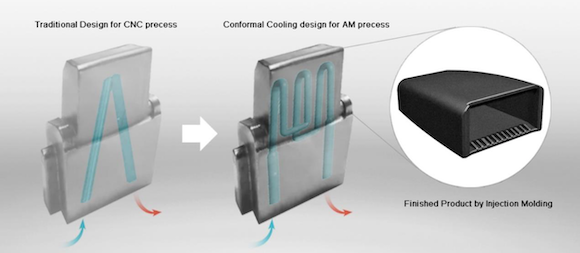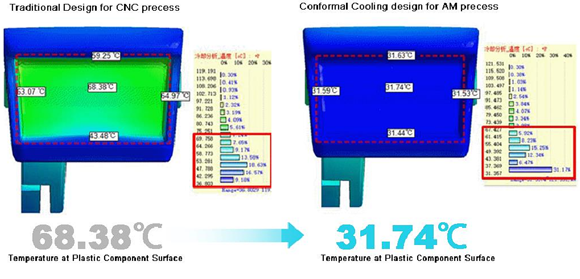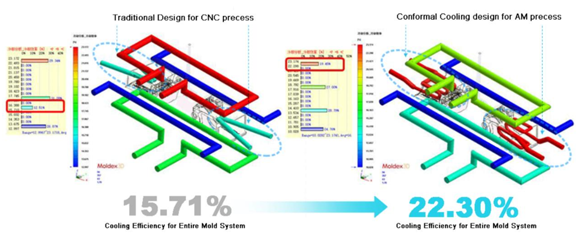Farsoon improves cooling mould manufacture for auto industry
February 5, 2021

Farsoon Technologies, Changsha, Hunan, China, recently published a case study on its success in achieving optimal conformal cooling mould manufacturing using Laser Beam Powder Bed Fusion (PBF-LB).
Moulds are an essential part of the modern manufacturing industry, utilised in a variety of aspects. The ability to produce quality parts with efficiency and profitability makes the use of moulds a valuable tool in the automotive industry, which, in turn, drives the creation of more sophisticated moulds with industry-specific requirements.
Traditionally, mould producers have had difficulty in meeting these demands, meaning manufacturers and suppliers are on the lookout for new technology that may advance mould production.
The subject of this study was the manufacture of a mould insert designed for serial production of plastic automobile rear seat safety buckles, produced using a typical injection moulding process. The controlled flow and cooling of the liquified plastic is critical to the finished plastic part, meaning the liquid must be dissipated uniformly in the mould throughout the cooling process. How the mould cooling channels are designed is critical in achieving this.
Before the introduction of Additive Manufacturing, the traditional manufacturing process for this mould would be based on a CNC process that could only produce linear cooling channels, which have varied offsets from the mould surface.
This limitation makes it harder to ensure uniformity of temperature during cooling, leading to irregularities which result in very high deformation rates for the finished product. In combination with the fact that a more efficient cooling process decides the production cycle time for parts, AM’s efficiency is necessary for the best production cycle.
The ability to create production tooling for these parts has become a defining competitive factor in the mould market. With this in mind, Ruixiang Moulding Co, Ltd, Shantou, Guangdong, China, adopted Farsoon’s FS271M AM machines in 2017. The ability to additively manufacture optimised mould designs with 18Ni300 material illustrated the theorised increase in efficiency and reduction of production time.
The Farsoon FS271M offers a wide scope of flexibility in cooling channel design. In this case, the insert portion of the mould is the area of greater heat concentration, necessitating greater density and complexity of the cooling channel design. A brand-new conformal cooling channel design has been developed and produced on the FS271M: not only does it expand internal surface area of the cooling channel, but lays closer and more evenly to the component contour, resulting in a much more uniform and efficient heat.
In order to test the cooling efficiency of moulds designed for traditional CNC processes against these new designs for conformal cooling, software produced by Moldex 3D, based in Taiwan, was used for the temperature simulation test. The heat concentrated area was selected for applying several key test points on the plastic component’s surface.

To best simulate the conditions of the cooling process, the mould temperature was set to 35°C and the injected plastic temperature to 259°C. In the illustration above, the real-time temperature distribution of the part is displayed in different colours to show the calculated three-dimensional heat distribution. The simulation results show a temperature drop from 68.38°C to 31.74°C in the region of interest in the plastic component in the same amount of time, a significant decrease of 36.64℃.
The below illustration shows the positive effects of an additively manufactured mould with conformal cooling channels, with efficiency increased from 15.71% to 22.30%.

Because cooling is a key factor in guaranteeing quality in the final product, the time required for this process alone usually takes a large proportion of the production cycle. With Farsoon’s AM technology, Ruixiang’s mould cooling time is reduced from 25 to 13 seconds, which helps to reduce the total production cycle from 43.6 to just 31.6 seconds.
“The adoption of Farsoon additive technology has been proved to be successful for series production. Our safety seat buckle was able to cut the production cycle by 28%. It brings great improvement to production volume and part quality, which has brought a positive impact on our clients,” stated Mr Zhang, General Manager at Ruixiang Mould. “Additive technology not only brings us increased profitability, but also differentiates our products and quality in the competitive moulding industry. We are looking forward to further development of more optimal applications with Farsoon additive technology.”
















